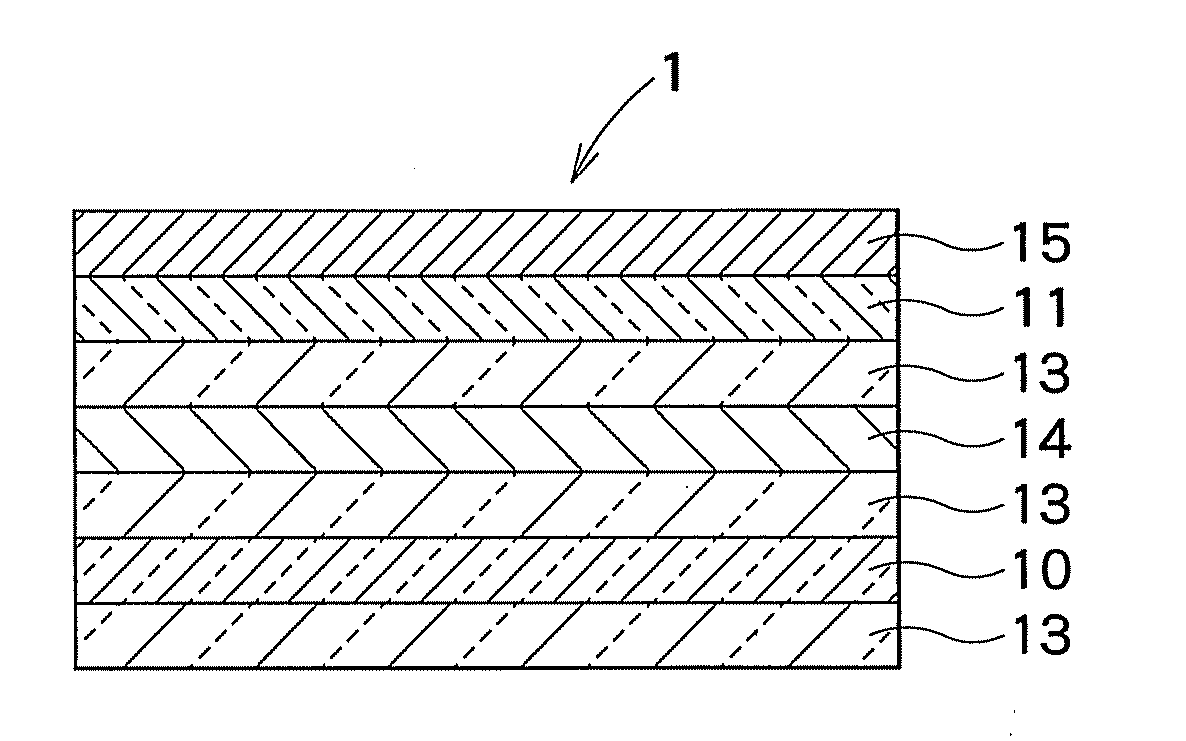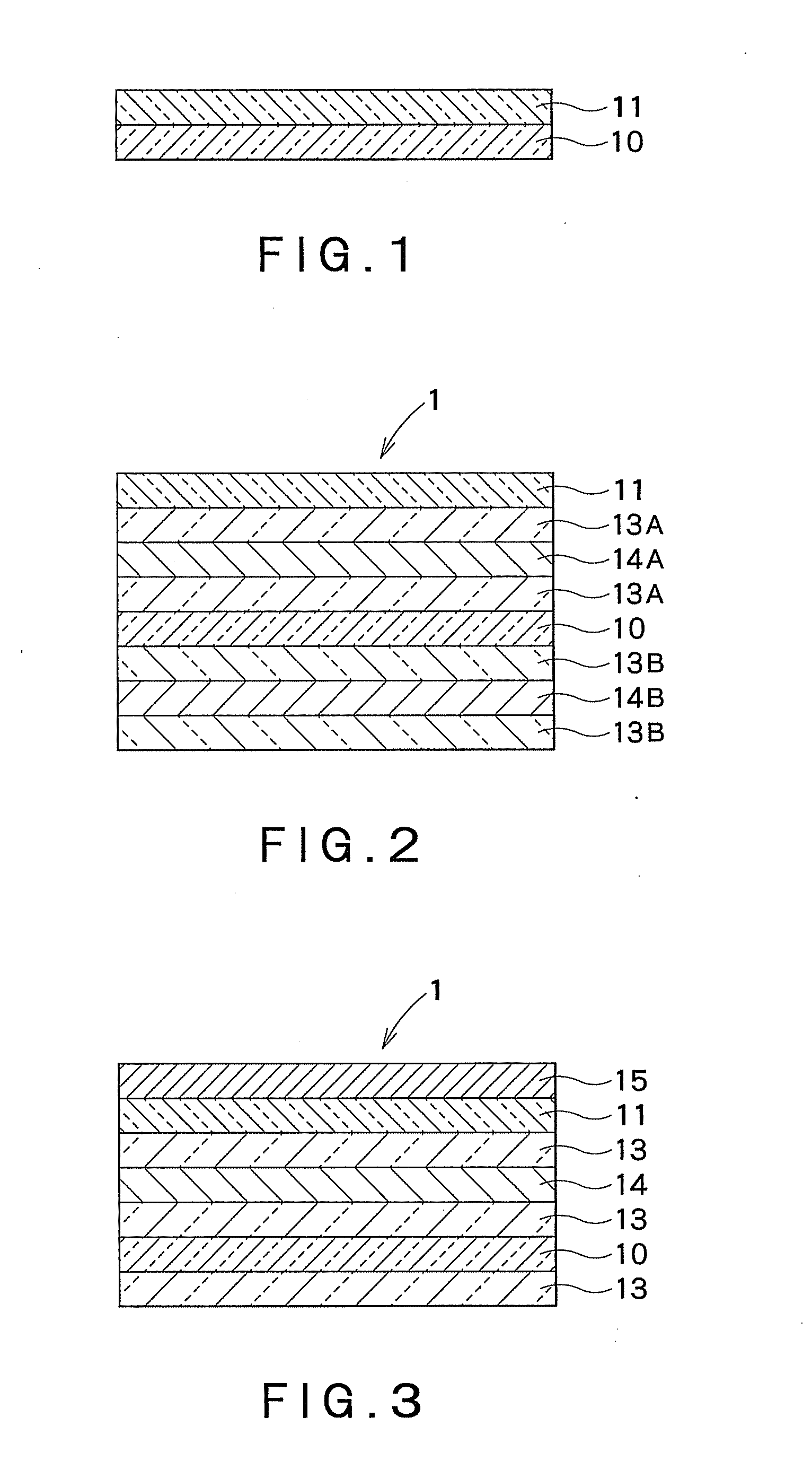Film with transparent electroconductive membrane and its use
a technology of electroconductive membrane and film, which is applied in the direction of conductive layers on insulating supports, instruments, transportation and packaging, etc., can solve the problems of unavoidable step of developing a resist, deformation, and significantly inferior heat resistance or moisture resistance of conventional synthetic resin films, and achieve excellent acid resistance, good surface flatness, and high luminescence brightness
- Summary
- Abstract
- Description
- Claims
- Application Information
AI Technical Summary
Benefits of technology
Problems solved by technology
Method used
Image
Examples
example a
[0213]The first invention is further illustrated by the following Examples and Comparative Examples that are not intended as a limitation of the invention.
[0214]Materials and formation methods for individual layers used in the Examples and Comparative Examples will be summarized.
[0215](1) Base Material:
[0216]“Polyethylene naphthalate” (manufactured by Teijin Ltd., Teonex Q65 (100 μm)) was used as a base material in the Examples.
[0217](2) Smoothing Layer:
[0218]A sol-gel layer used as a smoothing layer was formed by spin coating a coating agent composed mainly of an aminoalkyltrialkoxysilane, drying the coating on a hot plate at 120° C. for two min and then in an oven at 160° C. for one hr to form a 1.2 μm-thick sol-gel layer (a flattening layer).
[0219]An UV cured resin layer used as a smoothing layer was formed by coating the following UV cured resin composition, drying the coating at 120° C. for two min, and then applying ultraviolet light (UV) with a high pressure mercury lamp to c...
example a1
[0243]A 0.5 nm-thick ITO film was formed on a base material by magnetron sputtering using ITO as a target under conditions of electric power 2.0 kW and Ar gas 500 sccm and was held in vacuum for 15 sec. These two steps were repeated 300 times to form a 150 nm-thick ITO film. For the ITO film as the uppermost layer, the particle diameter of the crystalline secondary particles and the number of crystalline secondary particles were measured and were found to be 0.3 μm and 5 particles / μm2, respectively. The half-width value in the maximum peak of the crystal phase was 4.15. In order to form a 15-μm line by photolithography, the ITO layer was patterned with an etching liquid. As a result, the residue of the ITO particles was not observed under an optical microscope, and good patterning could be realized.
example a2
[0244]A 15 nm-thick ITO film was formed on a base material by a resistance heating-type vacuum deposition method. ITO particles were used as a material for the vapor deposition. The heating temperature was 1500° C. Plasma treatment was then carried out using a DC power supply under conditions of electric power 1 kW, Ar 200 sccm, and oxygen 500 sccm for 15 sec. These two steps were repeated ten times to form a 150 nm-thick ITO film. For the ITO film as the uppermost layer, the particle diameter of the crystalline secondary particles and the number of crystalline secondary particles were measured and were found to be 0.8 μm and 15 particles / μm2, respectively. The half-width value in the maximum peak of the crystal phase was 6.50. In order to form a 15-1 μm line by photolithography, the ITO layer was patterned with an etching liquid. As a result, the residue of the ITO particles was not observed under an optical microscope, and good patterning could be realized.
PUM
| Property | Measurement | Unit |
|---|---|---|
| Length | aaaaa | aaaaa |
| Transparency | aaaaa | aaaaa |
| Nanoscale particle size | aaaaa | aaaaa |
Abstract
Description
Claims
Application Information
 Login to View More
Login to View More - R&D
- Intellectual Property
- Life Sciences
- Materials
- Tech Scout
- Unparalleled Data Quality
- Higher Quality Content
- 60% Fewer Hallucinations
Browse by: Latest US Patents, China's latest patents, Technical Efficacy Thesaurus, Application Domain, Technology Topic, Popular Technical Reports.
© 2025 PatSnap. All rights reserved.Legal|Privacy policy|Modern Slavery Act Transparency Statement|Sitemap|About US| Contact US: help@patsnap.com



